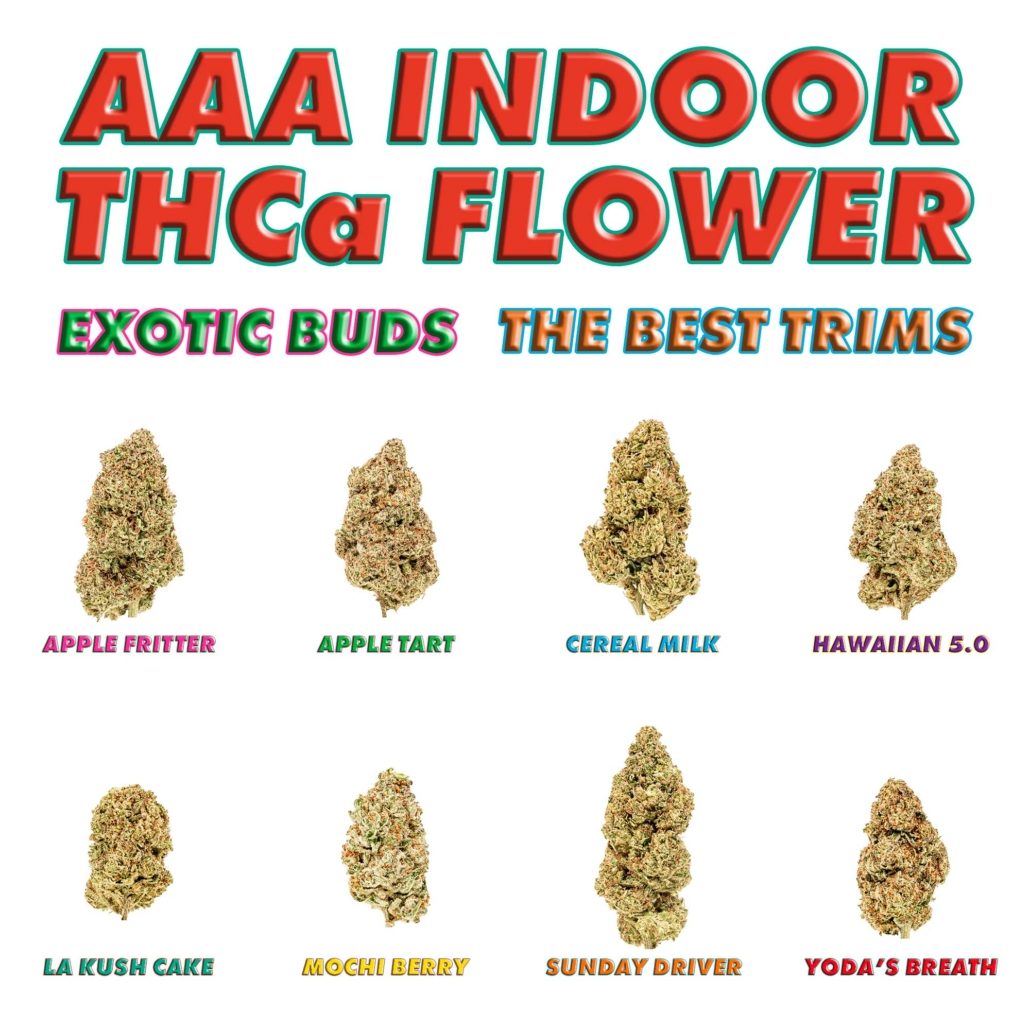THCa Bud
The THCa bud galaxy spins with endless variety. Each strain is a world of its own, glowing with bright terpenes, distinct aromas, and potent effects. At Earthy Select, we see THCa Bud as a launchpad for flavor-driven experiences grounded in cannabis science and shaped by meticulous third-party testing.
In this guide, we’ll help you find bold taste, reliable potency, and legal peace of mind. You’ll examine the science behind THCa, a map of standout strains, and insights into how these buds can fit into your day.
What Is THCa Bud and How Is It Made?
THCa Bud is premium cannabis that’s rich in THCa, the raw form of THC. In its natural state, THCa doesn’t get you high—only when it’s heated, like when you smoke or vape it, does it turn into regular THC and produce the effects people love.
Earthy Select’s THCa Bud is grown from specially selected hemp plants that naturally have high levels of THCa. These plants are carefully cultivated, harvested, and cured to keep the THCa levels high and the flower fresh and flavorful.
What makes THCa Bud special is that it gives you the full experience of cannabis while staying compliant with federal hemp laws. It looks, smells, and smokes just like top-shelf cannabis, offering strong effects and rich flavors—all without the heavy regulations tied to regular marijuana.
With Earthy Select’s THCa Bud, you get the quality and potency you expect, made with care from seed to jar.
Showcasing THCa Bud Strains by Earthy Select
Every THCa Bud strain from Earthy Select is a sensory world. This hand-selected flower is packed with rich cannabinoids and bursting with aromatic terpenes, delivering consistent potency and complex flavors. Whether you’re chasing clarity, creativity, or deep relaxation, this lineup has a perfect match.
Grown using organic practices, Earthy Select’s THCa Bud contains 20% to 30% total cannabinoids and is lab-tested for quality. Below, we break down each standout strain, what each tastes like, how it smells, what to expect when it kicks in, and the best way to experience it.
Sativa-Dominant Hybrid Strains
- Apple Fritter: A fusion of warm apple pastry and earthy nuttiness, this strain smells like a fall dessert cooling the windowsill. The effect is an energetic calm — mentally uplifting, without rushing the body.
- Best for: Mid-morning creative sessions or powering through house projects with a playlist in the background.
- Apple Tart: Bright green apple collides with tart berries and a whiff of gassy sweetness. It opens with a burst of mental energy that settles into steady focus.
- Best for: Crisp walks outside, energizing your afternoon, or curating a photo edit with laser vision.
- Cereal Milk: Creamy vanilla meets pine and soft herbs, creating a smooth and mellow inhale. Expect a subtle lift that feels both relaxed and alert.
- Best for: Slow-start mornings, planning your week, or reading with a warm drink in hand.
- Hawaiian 5.0: Tropical fruit explodes on the nose with hints of spice and sugar. This one shifts your mood to playful and sociable within minutes.
- Best for: Beach days, unexpected adventures, or dancing barefoot in the kitchen after dinner.
- Best for: Beach days, unexpected adventures, or dancing barefoot in the kitchen after dinner.
Indica-Dominant Hybrid Strains
- LA Kush Cake: Sweet vanilla cake with fresh mint and pine makes for a nostalgic scent. The body release comes on steadily and grounding, easing tension without fogging the mind.
- Best for: Low-lit evenings, winding down with a movie, or easing into restorative yoga.
- Mochi Berry: Cardamom spice and charred oak give this strain a rich, toasty aroma. The full-body calm is soothing but keeps you present and thoughtful.
- Best for: Journaling before bed, cozying up with lo-fi beats, or watching the rain from your porch.
- Sunday Driver: Sour citrus and ripe berries fade into a subtle diesel finish. Expect stress to dissolve, making space for stillness and steady breath.
- Best for: Warm baths, breathing exercises, or quietly folding laundry to reset your rhythm.
- Yoda’s Breath: Earthy citrus and sharp gas dominate the first inhale, followed by a sweet, honey-like exhale. The effect is both grounding and introspective.
- Best for: Solo meditations, late-night writing, or unplugging after a long social day.
Unmasking the Science Behind THCa
Think of THCa as the spark waiting for ignition. In its raw form, this cannabinoid stays quiet, but transformation begins when heat enters the picture. What starts as a calm, acidic molecule shifts into THC, kicking off a chain reaction that affects how the body and mind respond. Below, we’ll trace this evolution, from chemical change to physical effect.
Decarboxylation: The Catalyst That Activates THCa
Raw cannabis is rich with THCa, but that compound doesn’t deliver psychoactive effects on its own. To unlock the signature high associated with cannabis, THCa needs to go through decarboxylation. This process happens when heat is applied, through smoking, vaping, or baking, causing the THCa molecule to release a carbon atom and convert into delta-9 THC.
This shift may sound simple, but chemically speaking, it’s a big leap. The acidic group that’s lost during heating is what keeps THCa non-intoxicating. Once removed, the molecule fits more easily into CB1 receptors in the brain. That’s when users begin to feel the euphoric, relaxing, or energizing effects, depending on the strain. Without this heat-triggered step, raw THCa remains stable and inactive.
How THC Interacts with the Body
After THCa transforms into THC, the real chemistry begins. THC binds primarily to CB1 receptors in the endocannabinoid system, especially in the brain and central nervous system. These receptors influence mood, appetite, pain response, and memory. They trigger physical and mental effects when activated, depending on your dosage, tolerance, and unique biology.
While euphoria is the most recognized effect, THC’s interaction also stimulates hunger cues, relaxes muscles, and, for some, sparks creativity or calm. This dynamic response is what makes cannabis versatile. Whether someone seeks relief or recreation, the journey starts with how THCa transitions and locks into place within the body’s system.
Meanwhile, research suggests that THCa in its raw form may offer additional benefits, such as inflammation relief or anti-nausea support, without needing activation. This allows users to explore psychoactive and non-psychoactive pathways based on how they consume the bud.
What’s the Difference Between THCa and THC?
THCa and THC may share a chemical lineage, but their legal identities couldn’t be more distinct. While earlier sections explored how THCa converts into THC and what that means for effects, this one breaks down how their legal status can shape your buying decisions.
THCa is federally legal when derived from hemp and remains non-psychoactive in its raw form. THC, on the other hand, is classified as a controlled substance under federal law, even though it’s legal for recreational or medical use in many states. Below is a quick breakdown of where they stand:
- THCa is legal under the 2018 Farm Bill as long as it’s derived from hemp and the final product contains less than 0.3% delta-9 THC by dry weight.
- THCa Flower is often sold legally online because it meets the hemp-derived, low-THC threshold set by federal guidelines.
- THC products cannot be shipped across state lines unless explicitly allowed by state law, which limits availability to in-state purchases.
- THCa’s legality depends on chemical composition at the time of sale, not what it becomes when heated. This loophole allows consumers to legally purchase high-THCa Flower that becomes THC only when smoked or vaped.
- State laws may vary. Some states have tightened restrictions around THCa even if it qualifies under federal hemp laws. Always check your local rules before ordering.
Read more:
Frequently Asked Questions About THCa Bud
What’s the difference between THCa Bud and flower?
There’s no major difference since THCa Bud is cannabis flower. The term “THCa Bud” simply refers to flower that has been harvested, handled, and packaged in a way that preserves its raw, non-decarboxylated state.
Is THCa psychoactive?
THCa is the precursor to THC, the compound responsible for the psychoactive effects of cannabis. In its natural state, THCa is not psychoactive. However, when it’s heated through smoking or vaping, it converts to THC and becomes psychoactive. So, it’s all about the temperature!
How do you store THCa Bud to preserve potency?
Storing THCa Bud is all about maintaining its freshness and potency. Keep it in a cool, dark place, away from light and heat sources. An airtight container is your best bet to avoid exposure to air, which can degrade the cannabinoids over time.
Can you get high from consuming raw THCa Bud?
Eating raw THCa Bud won’t get you high. As mentioned, THCa needs to be heated to convert into THC, which is the component that produces psychoactive effects. So, if you’re munching on raw THCa Bud, you won’t experience the high you’d get from smoking or vaping.
Can THCa appear on a drug test?
Drug tests typically screen for THC, the psychoactive compound. If your THCa is converted to THC through heating, processed by the body, it could potentially trigger a positive result on a drug test. If you’re concerned about drug testing, it’s best to stay informed about your consumption method and potential detection.
What are the differences between THCa and CBD?
THCa and CBD are both non-psychoactive cannabinoids in their raw forms. However, they interact with the body’s systems differently. THCa converts to THC when heated, whereas CBD does not. CBD is known for its potential calming and anti-inflammatory properties, while THCa, before it’s heated, is studied for other possible health benefits, like anti-nausea and neuroprotective properties.
What are the potential side effects of THCa?
THCa is generally well-tolerated, but it can have side effects like any compound. Some people might experience dry mouth, dizziness, or changes in appetite. It’s essential to start with small amounts and see how your body reacts.
Are there any drug interactions with THCa Bud?
It’s always wise to consult a healthcare professional if you take other medications. While research on THCa is ongoing, it could interact with drugs metabolized by the liver or affect medications that alter heart rate and blood pressure. As always, proceed with informed caution.
Medical Disclaimer / Legal Disclaimer – Information is provided for educational purposes only. It does not, and is not intended to, constitute legal advice or medical advice. We strive to be accurate and up-to-date, but the legality of cannabinoids and the science of cannabis are continually evolving. The author is neither a legal professional nor a medical expert. Before buying or using any products, you should consult with your local authorities and medical providers.
Sources:
- Kim, J., Choi, P., Park, Y. T., Kim, T., Ham, J., & Kim, J. C. (2023). The Cannabinoids, CBDA and THCA, Rescue Memory Deficits and Reduce Amyloid-Beta and Tau Pathology in an Alzheimer’s Disease-like Mouse Model. International journal of molecular sciences, 24(7), 6827. https://doi.org/10.3390/ijms24076827
- Jaeger, K. (2024, May 13). DEA says THCA does not meet the definition of legal hemp as Congress weighs cannabinoid recriminalization in Farm Bill. Marijuana Moment. https://www.marijuanamoment.net/dea-says-thca-does-not-meet-the-definition-of-legal-hemp-as-congress-weighs-cannabinoid-recriminalization-in-farm-bill
- Rock, E. M., Kopstick, R. L., Limebeer, C. L., & Parker, L. A. (2013). Tetrahydrocannabinolic acid reduces nausea-induced conditioned gaping in rats and vomiting in Suncus murinus. British journal of pharmacology, 170(3), 641–648. https://doi.org/10.1111/bph.12316
Click here to add your own text


